
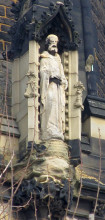
Spire and one of the tower sculptures, St Stephen's Rochester Row.
Spire and one of the tower sculptures, St Stephen's Rochester Row.

Off Vauxhall Bridge Road a little south of Victoria Street, is the tall spire of St Stephen’s Church Rochester Row, a church of interest to these pages for several reasons, and most notably its beautiful mosaics.
The church is built in a 14th Century Gothic style, made out of ragstone with the edgings and surrounds and details in Caen stone. On the north side, facing the street, is a solid porch, with clustered pillars, and crocketing and carved decoration to the little roofs above several niches, and little carved heads by a local sculptor, Peter Wright of Vauxhall Bridge Road. His too, apparently, is the kneeling stone figure of St Stephen above the porch entrance, and the various other carved heads etc outside the church, rather worn and evocative, and inside, in good preservation but painted.
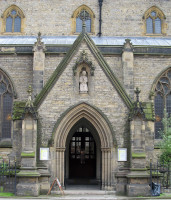
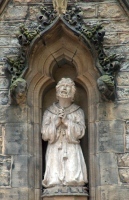 Porch, and statue of St Stephen.
Porch, and statue of St Stephen.
St Stephen’s Rochester Row was built for Baroness Burdett-Coutts, a member of the Coutts banking family and philanthropist, as a memorial to her father (see this page for the memorial she put up at St Pancras). The architect of St Stephen’s was Benjamin Ferrey (1810-80), one-time student of the elder Pugin, later of William Wilkins (of National Gallery fame), and who achieved considerable success as an architect and within the official architectural establishment; his accomplishments include laying out part of Bournemouth, and ecclesiastical restoration work at Wells Cathedral. St Stephen’s Rochester Row was completed in about 1847, and Ferrey’s design included a tall tower, its steeple reaching almost 200ft high, which was singularly ill-fated, being struck by lightning early in its life, and damaged in WW2, leading to its eventual demolition – the current spire, still very tall and a landmark, dating from 1994. The base of the spire is seated on the tower, which bears four crocketed spirelets which survived, and between them, a niche on each side enclosing a statue of saint. Being rather high up and viewable only obliquely, they are hard to appreciate, and are rather worn. I have a vague recollection of reading that they were the work of the sculptor Nathaniel Hitch, who made many church sculptures, but cannot find a source.
Within the church, we note the mosaics, the monuments, and the stained glass. First the mosaics.
Tennant Chapel mosaics, East wall.
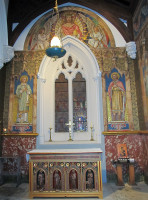

The mosaics completely fill the small Tennant Chapel, which has two main sides, to the east and to the south, the others being open. It dates from 1904, and, so information in the Church informs us, is to Angela Tennant, God-daughter to Baroness Burdett-Coutts.
There are four vertical panels depicting saints, each standing upright with a gold background, and blue to the upper portion:
Details of St Stephen, St Paul, St Peter, and Edward the Confessor.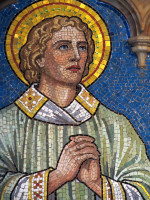
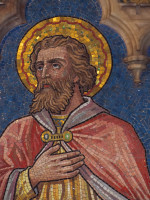
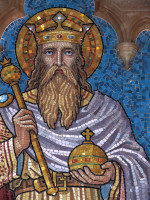
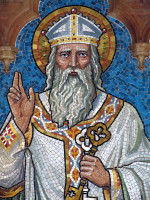
To the east: left of the window, Saint Stephen is shown as a young man without a beard, light hair, hands clasped together, beseeching rather than palm against palm in prayer. He wears a pale green smock, with the folds mostly vertical and undisturbed, except on the wide sleeves. Under this, he wears a long robe to the floor;
To the right of the window, an older Saint Paul, bearded, one hand on his chest, the other on his unsheathed sword. He wears a pale tunic held by a belt above the waist, and an outer red robe.
Saint Peter, an elderly man with white beard and hair, one hand holding his keys, the other raised in a Byzantine gesture of benediction. His white outer robe, with long sleeves, has a decorated collar and central vertical stripe, convincingly rendered over the folds underneath. We see two under layers, tan-coloured and white.
The last figure is King Edward the Confessor, holding orb and scepter, and crowned. He has a forked beard and heavy moustaches,and wears a tan tunic – no wide sleeves here with a belt, over which is his cloak, gathered Roman style over one arm, and hanging down behind.
The arch above the East facing side contains a half figure of Christ, also crowned, and with orb and scepter, and a sunburst behind. To each side is a kneeling female angel, in a nice composition where each angel has one wing upwards and one downwards, to nicely fill the space. The cloak of Christ and the garments of the angels contain the most carefully worked out drapes, and are of a high standard.
Finally, we have a row of winged cherubic heads, rather symbolist in their rendering. If you like such things, you may be interested in the page on winged cherub head sculpture.
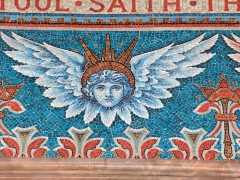
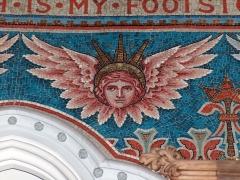 Winged cherubic heads in different hues.
Winged cherubic heads in different hues.
The ensemble as a whole is carried out in Venetian mosaics, using primarily gold and blue most effectively to give a sense of richness and opulence. The style is illustrative, including the use of black edgings for the principal lines, and the faces particularly looking like some painting by the Religious Tract Society, but the detail and colour scheme is fine Arts and Crafts. The best faces are those of St Paul, in a careful mix of darker flesh tones, and of the two female angels, which look to have drawn something from the Burne-Jones window noted below. The hands are generally of a high standard, with the upraised hand of St Peter being the one to look at. The mosaic maker knew his craft, and makes use of several ways to enhance the visual impact, for example the jeweled effect of the halos is increased through the use of green mosaic intermixed amongst the gold, and there is a slight variation to the angle of the backing mosaics to improve the precious, glittery aspects of the work.
Stained glass by Edward Coley Burne-Jones.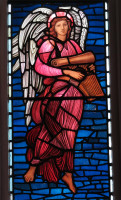
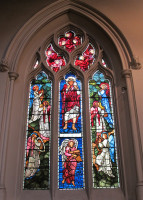
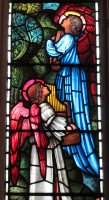

The pick of the stained glass in St Stephen’s is the Burne-Jones window, called The Good Shepherd, in memory of William Tennant, first Vicar of the parish, and wife Anne, and dated 1890. A characteristic work of Burne-Jones, in the colouring and poses, and the ascending angels on each side of the central light, with Good Shephard above, and angel playing some imaginary musical instrument below – Burne-Jones picked up the habit of inventing odd little musical instruments from Rossetti, his early master. The faces on the right hand side, particularly the lowest angel, are a little unusual for Burne Jones, but the central male figure has archetypical face, hands and sandalled feet, and the girlish face of the angel underneath is very Pre-Raphaelite. The variety of drapery styles in this work are worth study, again most notably on the lower central angel, in 16th Century style, and the carefully shaded medieval style of the figures on the upper left; contrast with the Y-folds of the cloak of the Good Shepherd.
The backgrounds are also varied, with the upper left and right hand sides with leaf patterns characteristic of William Morris’s firm which produced the window, and the rest much simpler, the central panel having a plain backing. The uniting factors are the composition, and the fantastic deep colours reinvented by Morris and Co. At the top, the curves of the tracery allow for three larger lights, each with angelic heads surrounded by a mass of deep red feathering, and two small elongated ones, each holding a single red flower with pale leaves. By some coincidence, the William Morris Art Bronze Foundry, making statues, statuettes and architectural bronze work, was situated just along Rochester Row.
Other glass in the church is by Wailes, good of its type, but seeming rather subdued compared to the glowing colours of the Morris glass.
Stained glass by Wailes, and details.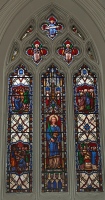
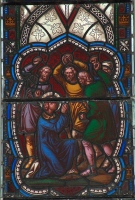
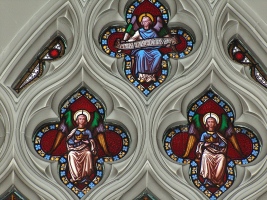
The monuments are few, as by the time the Church was built in the mid-19th Century, the main period of church monuments had come to the end, and there was a ban on burying anyone except Miss Burdett-Coutts (who ended up in the Abbey) and and two others. Nevertheless, we may note the following:
G.G. Adams' sculptural panel for William Brown, d.1855.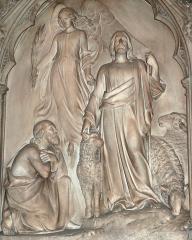
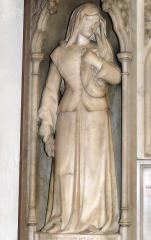
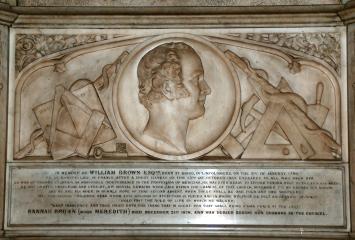
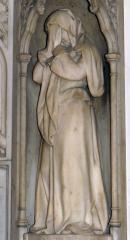
William Brown, d.1855, with an added dedication to his wife Hannah, d.1878 - a good Victorian wall plaque, Gothic work, with ornate top edge and pinnacles in the spirit of the exterior of the Church, and of course more delicately carved. Within the Gothic arch is a central scene of Christ with sheep, a kneeling supplicant, and behind and above, an angel holding a leafy branch. Beneath this, a panel containing a roundel with a relief portrait of the deceased, oddly tending to the Classical in its treatment. Beside this is a Staff with a snake wound around it, symbolic of his medical profession, but he clearly had other interests, for we also see various masonic and mathematical accoutrements, a Bible and a key, the latter presumably intended to suggest his heavenly destination. Flanking this, thus under the side pilasters of the monument, are two deep niches, each containing a small standing female figure (if you want more niche figures, see this page). She on the left, cowled, young and slender, has one hand to her breast and the other holding a handkerchief; she to the right, a more solid figure, perhaps his widow, buries her face in a fold of drapery, while her other hand clutches a Bible. The sculptor of this interesting sculptural monument signs his work: George Gammon Adams.
Sir John Heron Maxwell, d.1885, typical revival brass panel, with the lettering in black, the main initials in red, and an inscribed line border; the corners of this are embellished with blue marbles in quatrefoils, and there is a pinky-brown alabaster backing.
William Robinson, Churchwarden to 1905, with enamelled shield.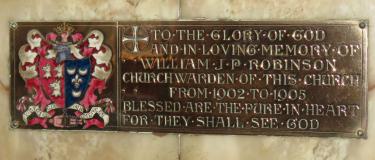
William J.P. Robinson, Churchwarden to 1905, which may be when he died. A coppery panel with a shield of arms on one side, looking to be enamelled rather than cold painted.
Montague Herbert, d.1918, alabaster and mosaic.
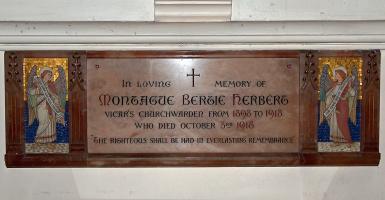

Montague Bertie Herbert, d.1918, central panel with two small flanking angels, painted, with a backing of gold and blue mosaic. Rather simply rendered, but with the mosaic, giving a rich feel; the alabaster surround, in a characteristic pinky-brown much favoured by the Arts and Crafts designers, has crocketed pinnacles in relief.
Arts & Crafts panel to Revd. Twining, d.1923.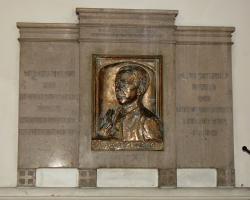
Revd. W. H. G. Twining, d.1923. An early 20th Century panel with elegant 1900s-style text and a central portrait bust in beaten copper. As with WWI memorials, it is not uncommon for post-war church monuments to conserve the style which had emerged two decades previously, before being swept away by the deliberately unornamented plaques which came to the fore during the 1920s and signaled the end of most sculpturally significant church monuments.
Bust of William Tennant, in white marble with a slight angle to the head giving a quizzical look. I saw no signature, but underneath is text that ‘ William Tennant..vicar.. d 1879…this bust, the work of a former pupil of the school [ie school of Burdett-Coutts] was erected by the Baroness Burdett-Coutts.’
Bust of William Tennant, d.1879.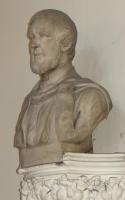
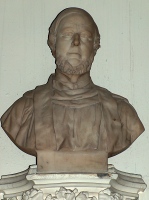
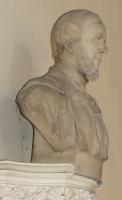
William Jones, d.1929, and George Bartlett, d.1937, identical wooden panels with frames.
St Stephen Rochester Row interior.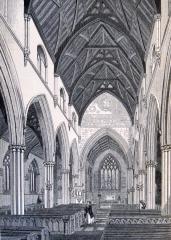
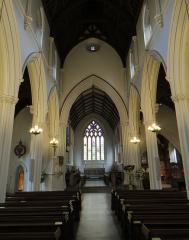
The body of the Church itself is fairly unchanged from when it was put up, though some mural patterning and text on the chancel arch, seen in the engraving above, has been whitewashed. Among the various furnishings, notable are:
Burdett-Coutts angel, font, sheep, altar table, War Memorial.
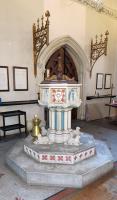
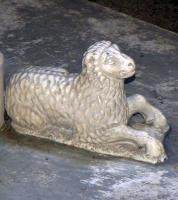
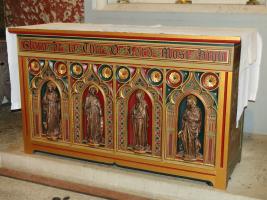


Back outside, we should note the rather grim schools and parsonage, now called the Burdett-Coutts and Townshend School, dating from 1849 (again by Benjamin Ferrey), 1876 and 1924. Baroness Burdett-Coutts paid for the School too, and also made a contribution to the group of Almshouses opposite the Church.
Rochester Row almshouses, and busts of James Palmer and Emery Hill.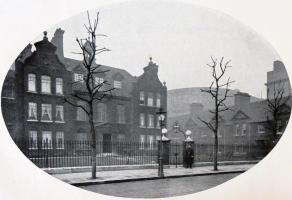
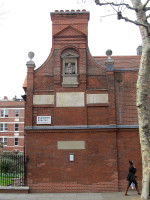
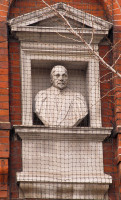
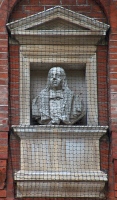
The Revd James Palmer’s almshouses, to be homes for a dozen poor persons, were founded in 1656, and Emery Hill’s Almshouses were founded in 1708 to home a further 12. They now form the United Westminster Almshouses, with central block with 2 detached wings. erected 1882. Various plaques on the wall inform us that £3000 was donated by Hannah Sarah Chadwick 1850, and also refer to Nicholas Butler's bequest of 1675. There are two busts. To the left is the Revd. James Palmer, Vicar of St Bride's in Fleet Street, made white stone, wearing skullcap and a cloak above some garment with a wide collar; he has a moustache and goatee beard. Carved in the late 19th Century, apparently the bust is based on a monument to Palmer in St Margaret's Westminster. The bust to the right, in somewhat darker stone, is Emery Hill, with shoulder-length hair, a buttoned shirt, and with a wide furry collar. This is a much older piece; Emery Hill died in 1675, and this bust is believed to have been carved shortly afterwards, maybe by Jaspar Latham, who made a monument to him, also in St Margaret's Westminster. The Classical surrounds of these two busts though, would look to date from the time of the 1881-2 reconstruction of the Almshouses.
With many thanks to the Church authorities for permission to show pictures of the monuments inside St Stephen's; their website is http://www.sswsj.org/.
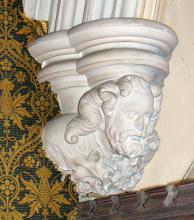 Another carving by Peter Wright of Vauxhall Bridge Road, inside the Church.
Another carving by Peter Wright of Vauxhall Bridge Road, inside the Church.
Introduction to Victorian and Edwardian Mosaics in London
Monuments in some London Churches // Churches in the City of London // Introduction to church monuments
Angel statues // Cherub sculpture
Visits to this page from 13 Mar 2014: 10,546